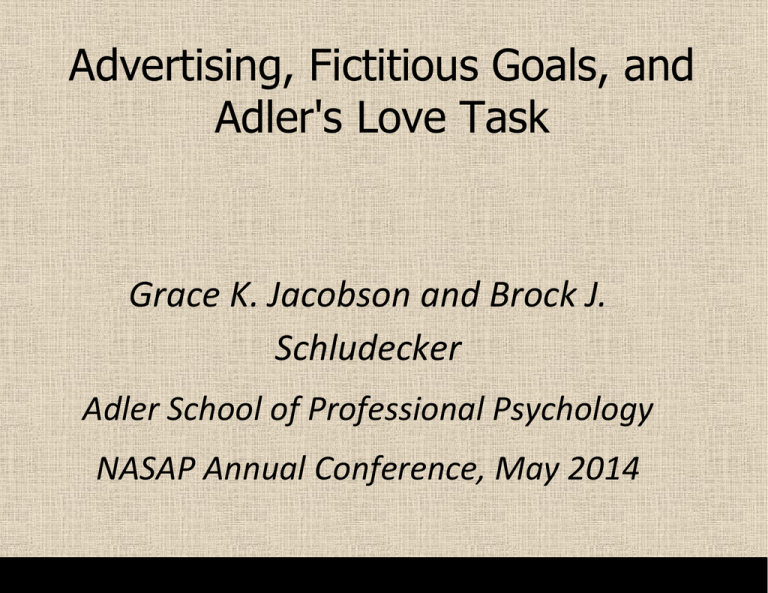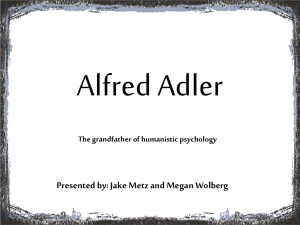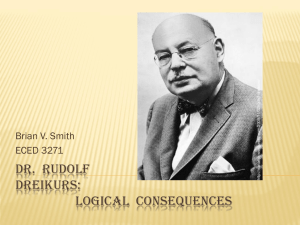
Advertising, Fictitious Goals, and
Adler's Love Task
Grace K. Jacobson and Brock J.
Schludecker
Adler School of Professional Psychology
NASAP Annual Conference, May 2014
Facets of the Love/
Sex Task
● Most difficult of the life tasks; requires the
most interpersonal cooperation:11
o Sexual role definition: What does it
mean to be a man/ woman?
o Sexual role identification: How
do I measure up to this definition?
o Sexual behavior: What is
appropriate sexual behavior?
“What is my
sexual selfideal?”
Success in the Love Task
“Cooperation is the chief prerequisite
for marriage.” - Alfred Adler 2
● Includes intimacy, love, marriage and sex.
○ The ability to be a good partner is a direct
reflection of one’s social interest.
○ Love is “the effort to ease and enrich the other’s
life”1
● The Dyad of perfect love
○ Zweisamkeit - “Twosomeness”4
“If we contemplate an escape, we do not collect
all our powers for the task” - Alfred Adler2
“...A hypercompetitive society can foster a faulty style of
personality development, where the exaggerated striving for
superiority impairs or halts the process whereby an individual
could learn the courage to love.” - Eiriek, 20016
Advertising’s Effect on the Sexual
Self-Ideal
“People have a natural drive to evaluate their own attributes and abilities,
which they do by comparing themselves with others” - Leon Festinger,
19547
➢ Men exposed to muscular-ideal
commercials had lower muscle
satisfaction and self-rated physical
attractiveness. This was most prevalent
for men who were appearance-oriented.9
➢ Women viewing moderately thin
models can actually assimilate, resulting
in higher self esteem than when looking
at moderately heavy models. But when
the models are extremely thin, women
have lower self-esteem than when they
view extremely heavy women.12, 13
Advertising’s Effect on Relational
Sexual Ideals
Research finds that...
➢ People who view pictures of attractive people feel less attractive, less
attracted to their current partners, and less satisfied with their sexual
lives.7
➢ Ads with sexual content affect men and women differently because
men and women think about sex differently:
MEN
WOMEN
● Men think about sex a LOT and
fantasize about sex with
multiple women.10
● Men believe and want to see
sexualized ads (ESPECIALLY
if they feel insecure).10
● Women associate sex with
feelings of intimacy and
relationship.5
● Women don’t identify with most
overtly sexual ads. They like
romantic ads that suggest
commitment. 5
Examples (females)
Examples (male)
Conclusions
● Contemporary ads reflect that difference in sexual ideal between
genders which had actually already been instilled through
socialization.
● Therefore, ads tend to REFLECT our own values back to us and say
“You know that this is what success looks like. If you buy our
product, you too can be successful and achieve love/sex.”
o Research suggests that ads don’t change people’s values.
People tend to buy products in line with their own selfconcepts and values. 8
● Looking at ads could make us feel further from the sexual ideal (both
intrapersonally and interpersonally), which might motivate us to buy a
product to better meet that ideal.
OR
● We didn’t need ads to compare to in the first place, and we are already
socialized to compare ourselves to others.
How might these implications be different if more people
were striving horizontally, rather than vertically?
Recommendations & References
Future research should take into account:
● The wide variety of types of media to examine: print, TV, film, social media,
pornography.
● Media targets different age groups based on cultural expectations around sex
for that age (e.g. different messages to teens vs adults).
● Cultural differences that might not value “Western” ideas of sex and love.
● Are people socialized differently in recent years due to the rising ability to
constantly access media?
1. Adler, A., Ansbacher, H. L., & Ansbacher, R. R. (1958). The Individual psychology of
Alfred Adler. Lond.: Allen & Unwin.
2. Adler, A., Ansbacher, H. L., & Ansbacher, R. R. (1978). Co-operation between the sexes:
writings on women, love and marriage, sexuality, and its disorders. Garden City, N.Y.:
Anchor Books.
3. Adler, A. (1971). Love is a recent invention. Journal of Individual Psychology, 27, 144152. (Original work published 1936).
4. Adler, A., & Stein, H. (2006). The general system of individual psychology: overview and
summary of classical Adlerian theory & current practice. Bellingham, WA: Classical
Adlerian Translation Project.
5. Dahl, D. W., Sengupta, J., & Vohs, K. D. (2009). Sex in advertising: Gender differences
and the role of relationship commitment. Journal of Consumer Research, 36, 215-231.
6. Eirik, S. (2001). The courage to love: Social interest and sexuo-morphological meaning.
Journal of Individual Psychology, 57(2), 158 - 172.
7. Galician, M. (2004). Sex, love, and romance in the mass media: Analysis and criticism of
unrealistic portrayals and their influence. Mahwah, NJ: Lawrence Erlbaum Associates.
8. Grohmann, B. (2009). Gender dimensions of brand personality. Journal of Marketing
Research, 46 (1), 105-119.
9. Hargreaves, D. A., & Tiggemann, M. (2009). Muscular ideal media images and men’s body
image: Social comparison processing and individual vulnerability. Psychology of Men and
Masculinity, 10 (2), 109-119.
10. Lindstrom, M. (2011). Brandwashed: Tricks companies use to manipulate our minds and
persuade us to buy. New York, NY: Crown Business.
11. Mosak, H. H., & Maniacci, M. (1999). A primer of Adlerian psychology: the analyticbehavioral-cognitive psychology of Alfred Adler. Philadelphia, PA: Brunner/Mazel.
12. Smeesters, D., & Mandel, N. (2006). Positive and negative media image effects on the
self. Journal of Consumer Research, 32, 576-582.
13. Wan, F., Ansons, T. L., Chattopadhyay, A., & Leboe, J. P. (2013). Defensive reactions to
slim female images in advertising: The moderating role of mode of exposure. Organizational
Behavior and Human Decision Processes, 120 (1), 37-46.












